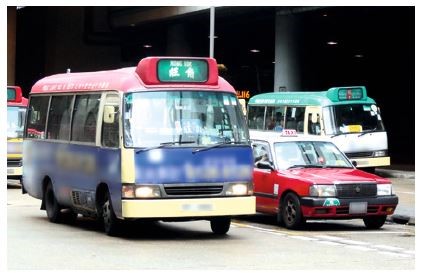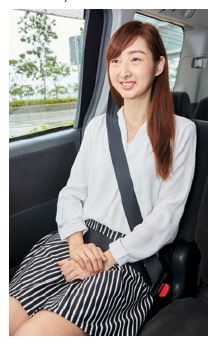
Using pubic light buses or taxis
Find a safe place to wait before hailing a taxi or public light bus. If a taxi stand or a public light bus stand or stop for the route you want is nearby, go there and wait. Do not wait where there is a stopping restriction which may prevent the driver from stopping to pick you up, for example where there are double yellow lines or single yellow lines (within the restriction time).
Wait near the kerb but do not stand too close to it or on the roadway. When a taxi or public light bus approaches, give a clear signal to the driver.
Do not step on the roadway or try to get in until the vehicle has stopped and the driver has opened the door for you or knows you are getting in. If the vehicle stops on the other side of the road, be sure that the driver has stopped for you and not for some other reasons, and follow the Road Crossing Code to cross the road.
Where possible, get in or out of a public light bus or taxi on the pavement or side of the road.
You must wear a seat belt, if fitted, when travelling on a public light bus or taxi.
When travelling by taxi, give early alert to the driver of any instructions so that the driver can carry them out safely. Follow the rules and advice for private car passengers (see this page).
Do not speak to the driver other than to give instructions. Do not try to pay directly to a driver while the vehicle is still in motion.
When you wish to get off a public light bus, press the call bell (if provided) or tell the driver well in advance so the driver can stop safely. Do not leave your seat until the public light bus has stopped.
If you are a taxi front seat passenger and it is necessary to get out onto the roadway, follow the advice for private car passengers getting out onto the roadway on this page.
|
( Chapter 8 'The Language of the Road' includes illustrations of traffic signs, traffic light signals and road markings referred to in this chapter.) |
For private car passengers
 Wait until the car has stopped before getting in or out. Where possible get in or out on the pavement or side of the road. You must not open the door in a manner that puts anyone in danger or impedes pedestrians. Do not leave the door open.
Wait until the car has stopped before getting in or out. Where possible get in or out on the pavement or side of the road. You must not open the door in a manner that puts anyone in danger or impedes pedestrians. Do not leave the door open.
If it is necessary to get out onto the roadway, do not open the car door until it is safe to do so. Ask the driver to help if necessary. Open the door a little, look all around, particularly behind, and listen. Watch out particularly for cyclists and motorcyclists. When there is no traffic, get out, stand by the car and close the door quickly. Look all around again and when there is no traffic nearby, walk around the back of the car to the pavement or the side of the road.
After sitting in a seat, buckle up. All passengers must always wear seat belts, if fitted (see page 43 for more information).
Do not distract the driver while the vehicle is in motion, or touch any of the controls or door locks. Do not throw anything out of the window or put out any part of your body.
If the vehicle is installed with airbags, ensure that there is a good distance between you and the air bag outlet. Do not sit or lean unnecessarily close to the airbag outlet.
(For more information on seat belts and air bags, see pages 43 to 46.)